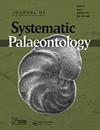New Oligocene Pseudocrenilabrinae cichlid fishes (Teleostei, Cichlidae) from freshwater deposits of Libya
IF 2.2
2区 地球科学
Q3 EVOLUTIONARY BIOLOGY
引用次数: 1
Abstract
Two species of fossil cichlid are described from Oligocene deposits of Libya. One is formally described as Libyachromis fugacior gen. et sp. nov. This species is considered to be the sister group to most of the remaining members of the African subfamily Pseudocrenilabrinae, perhaps close to Heterochromis, and is characterized by two predorsal bones, dorsal fin with 12–14 spines and 9–12 rays, 24–28 vertebrae, cycloid scales present on body and head including cheek, and only unicuspid teeth present on the oral and pharyngeal jaws. The second fossil form is less complete, and so we do not formally name it, but it appears to be most closely related to Tylochromis, and thus we place it in the Tylochromini. These new fossils increase our understanding of the diversity of cichlid lineages in the Palaeogene. The unnamed fossil supports the presence of Tylochromini in the Eocene and Oligocene of North Africa, as was previously suggested by the remains of partial lower pharyngeal jaws from Egypt and Libya. The named fossil adds to the known diversity of early Cenozoic cichlids that document the presence of probably Heterochromini along with Tylochromini in North Africa. http://zoobank.org/urn:lsid:zoobank.org:pub:435CD980-E4DB-4333-AB21-BDA38F9C6023利比亚淡水沉积物中新渐新世拟鲷鱼科慈鲷鱼
利比亚渐新世沉积物中描述了两种慈鲷化石。其中一种被正式描述为Libyachromis fuccior gen.et sp.nov。该物种被认为是非洲假克里尼氏亚科大多数剩余成员的姐妹群,可能接近异克里氏,其特征是两块前骨,背鳍有12-14根棘和9-12条射线,24-28节椎骨,身体和头部(包括脸颊)有摆线鳞片,口腔和咽颚上只有单尖牙。第二种化石形式不太完整,因此我们没有正式命名它,但它似乎与Tylochromis关系最密切,因此我们将其归入Tylochroni。这些新化石增加了我们对古近纪慈鲷谱系多样性的了解。这个未命名的化石支持了Tylochroni在北非始新世和渐新世的存在,正如之前埃及和利比亚的部分下咽颚遗骸所表明的那样。这一命名化石增加了已知的新生代早期慈鲷的多样性,记录了北非可能存在异铬鱼和Tylochroni。http://zoobank.org/urn:lsid:zoobank.org:pub:435CD980-E4DB-4333-AB21-BDA38F9C6023
本文章由计算机程序翻译,如有差异,请以英文原文为准。
求助全文
约1分钟内获得全文
求助全文
来源期刊
CiteScore
5.30
自引率
7.70%
发文量
31
审稿时长
>12 weeks
期刊介绍:
The Journal of Systematic Palaeontology publishes papers that provide novel and impactful results in phylogenetics and systematics and that use these results in ways that significantly advance rigorous analyses of palaeogeography, palaeobiology, functional morphology, palaeoecology or biostratigraphy. Papers dealing with theoretical issues or molecular phylogenetics are also considered if they are of relevance to palaeo-systematists. Contributions that include substantial anatomical descriptions, descriptions of new taxa or taxonomic revisions are welcome, but must also include a substantial systematics component, such as a new phylogeny or a revised higher-level classification. Papers dealing primarily with alpha-taxonomic descriptions, the presentation of new faunal/floristic records or minor revisions to species- or genus-level classifications do not fall within the remit of the journal.

 求助内容:
求助内容: 应助结果提醒方式:
应助结果提醒方式:


